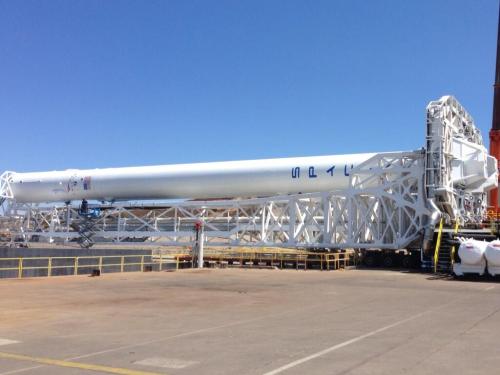SpaceX Launch Update
The maiden launch of the SpaceX Falcon 9 v.1, to be conducted out of Vandenberg AFB in California, has been pushed back from September 10th to the 14th, and if a recent tweet from company founder Elon Musk is any indication, further delays are possible, as the company attempts to cover every contingency for one of the most eagerly anticipated space launches in recent memory. While the Wet Dress Rehearsal has already been performed, there is no word yet regarding a test fire. Although neither SpaceX nor their primary customer, Canada’s MDA corporation are saying very much about the launch, which will boost the CASSIOPE spacecraft into a near polar orbit, the steady grind of government paperwork has revealed some fascinating details about the upcoming event. As has been widely speculated, SpaceX will attempt to perform a soft water landing of the vehicle’s first stage, in what will be a two-part process. After stage separation, the Falcon 9 v-1.1 will re-ignite three of its 9 Merlin 1d engines in an attempt to dramatically slow the stage before it re-enters the atmosphere and begins the violent tumbling recorded by sensors on previous flights of the original Falcon 9, Block I. If it is successful in this effort, then the rocket will conduct a second re-ignition and burn of the the single, center mounted Merlin engine in an effort to further slow the booster before it impacts the ocean. Obviously, there is quite a lot which could go wrong with this particular flight, and to cover contingencies, SpaceX applied for and received a waiver for certain FAA risk thresholds, specifically the risk of blast damage from an explosion due the anticipated development of a regional atmospheric inversion which would have the effect of increasing blast overpressure. The FAA regulation “prohibits the launch of an expendable launch vehicle if the total expected average number of casualties (Ec) for the launch exceeds 0.00003 for risk from far field blast overpressure.” Even if this initial powered recovery effort is a total flop, also contained in the FAA waiver is the hint of a possible silver lining. According to the waiver notice published in Federal Register, SpaceX plans to re-ignite the second stage and burn it to exhaustion. While this could take the form of a fuel intensive plane change maneuver, it could also indicate that the company is going to attempt to send the second stage out of Earth orbit altogether, and in doing so demonstrate not only the ability to perform a geostationary transfer orbit burn which will be needed for its upcoming SES launch out of Cape Canaveral, but also take a major step in marking out a future role for interplanetary missions. With the Osiris/Rex launch recently awarded to United Launch Alliance, it is a fair bet that SpaceX is more than eager to at least get the Falcon into serious contention for future high profile launch awards. (Not that many are coming anyway, due to SMD budget cuts) In the event SpaceX does go for broke, it should also be noted that with the same second stage intended for use in the Falcon Heavy, conducting an escape velocity burn, whenever it happens, will be a de facto demonstration of a a critical component required to deliver on the FH’s promise of significant throw-weight to both the Moon and Mars.


